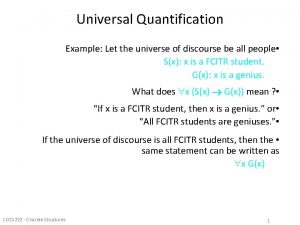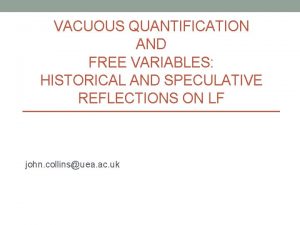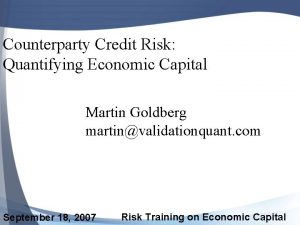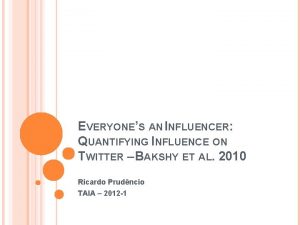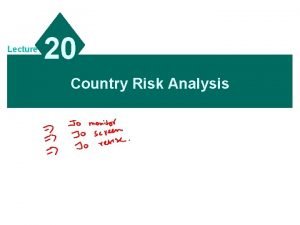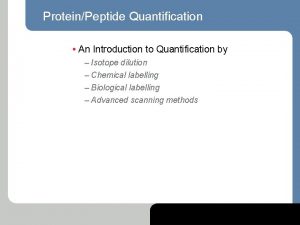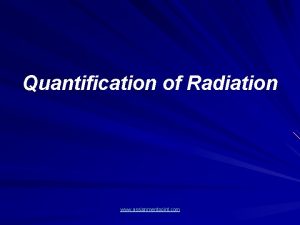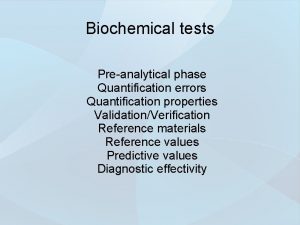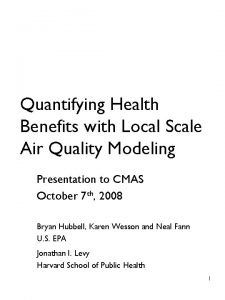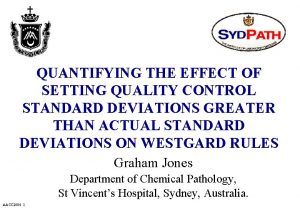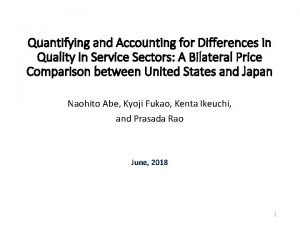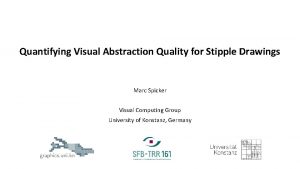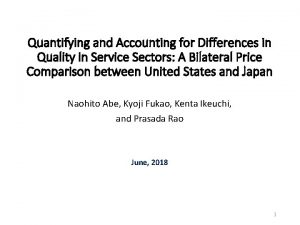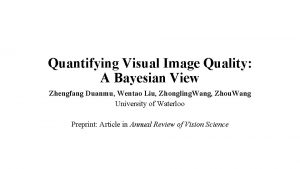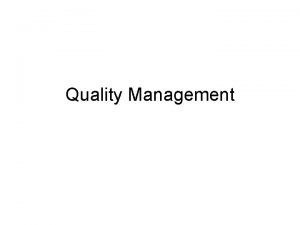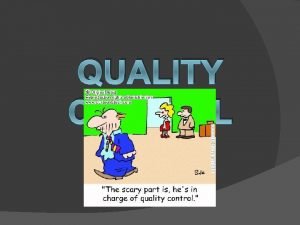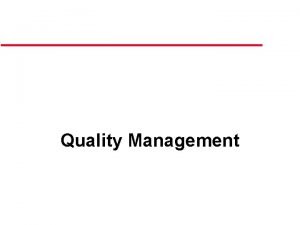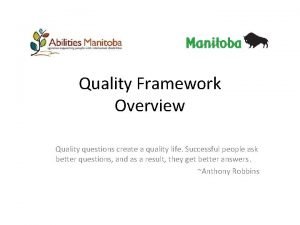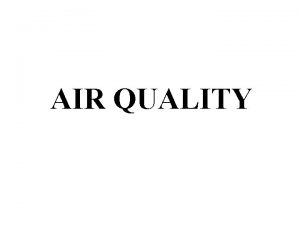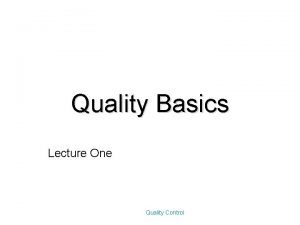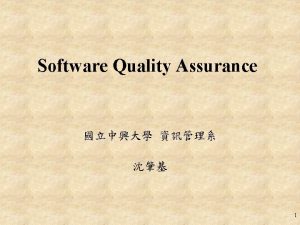Quantifying the Unquantified Quantifying Quality How quantification of










![Quantifying Quality Quantify for realistic judgements • “To leave [soft considerations] out of the Quantifying Quality Quantify for realistic judgements • “To leave [soft considerations] out of the](https://slidetodoc.com/presentation_image_h2/5598d7af26026a6c3d170cbdff0d1ab8/image-11.jpg)

































- Slides: 44

Quantifying the Unquantified: Quantifying Quality How quantification of key performance attributes can improve project audit, process audit and project management. Presented at The International Workshop on Software Auditing and Metrics (SAM 2004) at The International Conference on Enterprise Information Systems (ICEIS) 2003 ICEIS 2004 is organized and hosted by Universidade Portucalense - Porto (Portugal) http: //www. iceis. org/keynotes. htm 13 th April 2004 Tom@Gilb. com www. Gilb. com Result Planning Limited Norway/UK Tom Gilb 1

8. Quantify How to Quantify any Quantifying Quality Qualitative Requirement Diagram courtesy of Lindsey Brodie, Editor of Competitive Engineering. May 2000 Tom Gilb 2

Quantifying Quality Al Says “Not everything that can be counted counts, and not everything that counts can be counted. ” Albert Einstein I agree. But this does not include system qualities. Tom Gilb 3

Simon Ramo (t. Rw) Quantifying Quality “No matter how complex the situation, good systems engineering involves putting value measurements on the important parameters of desired goals and performance of pertinent data, and of the specifications of the people and equipment and other components of the system. It is not easy to do this and so, very often, we are inclined to assume that it is not possible to do it to advantage. But skilled systems engineers can change evaluations and comparisons of alternative approaches from purely speculative to highly meaningful. If some critical aspect is not known, the systems experts seek to make it known. They go dig up the facts. If doing so is very tough, such as setting down the public’s degree of acceptance among various candidate solutions, then perhaps the public can be polled. If that is not practical for the specific issue, then at least an attempt can be made to judge the impact of being wrong in assuming the public preference. Everything that is clear is used with clarity: what is not clear is used with clarity as to the estimates and assumptions made, with the possible negative consequences of the assumptions weighed and integrated. We do not have to work in the dark, now that we have professional systems analysis. Ramo 98 page 81 Simon Ramo and Robin K. St. Clair, The Systems Approach: Fresh Solutions to Complex Civil Problems Through Combining Science and Practical Common Sense, 1998, 150 pp, TRW, Inc. , Manufactured in USA, KNI Incorporated, Anaheim CA. Free copy at TRW Stand at INCOSE conference 2002. Tom Gilb 4

How to Quantify Quality Plan Quantifying Quality Use known quantification ideas Do Modify known quantification ideas to suit your current problems Study Use your common sense and powers of observation to work out new measures Act Learn early, learn often, adjust early definitions Tom Gilb 5

‘Environmentally Friendly’ Quantification Example Quantifying Quality Give the quality a stable name tag ENVIRON-FRIEND Define approximately the target GIST: A degree of protection ……. Define a scale of measure: SCALE: % change in environment Decide a way to measure in practice. METER: {scientific data…} Define benchmarks. PAST[2003] +50% <-intuitive RECORD [2002, …. ] 0% TREND [2007, …] -30% Define Constraints (Fail) and targets. Fail[next year] +0% <-not worse Goal +5 years, …. ] +30%<-TG Wish [2007, …] +50%<-Marketing Tom Gilb 6

Devices to help quantify quality ideas: Standard Hierarchy of Concepts from Gilb: Principles of Software Engineering Management. Quantifying Quality QUALITY USABILITY AVAIL-ABILITY MAINTAINABILITY 1. PROBLEM RECOGNITION 2. ADMINISTRATIVE DELAY 3. TOOLS COLLECTION 4. PROBLEM ANALYSIS ADAPTABILITY WORKCAPACITY RELIABILITY 6. QUALITY CONTROL 7. DO THE CHANGE 8. TEST THE CHANGE 9. RECOVER FROM FAULT 5. CHANGE SPECIFICATION Tom Gilb 7

Quantifying Quality Using ‘Parameters’ when defining a Scale of Measure Goal [ Users = NOVICES, Components = USER MANUAL, Tasks = ERROR CORRECTION ] 60% • Using [qualifiers] in the SCALE definition – gives flexibility of detailed specification later. • Example – SCALE: the % of • defined [Users] • using defined [system Components] • who can successfully accomplish defined [Tasks] [Scale Parameters] Tom Gilb 8

Quality Quantification Process (full detail ‘Competitive Engineering’, Scales chapter, & slide here later ‘QQ’) Entry Quantifying Quality E 1. Do not enter if you can reuse existing standards. E 2. Do not enter if your source documents are poor. Procedure P 1. Use applicable rules (GR, QQ). P 2. Build list of quality ideas needing control. P 3. Detail qualities by exploding hierarchically. - use evolutionary or pilot feedback. P 4. Revise your draft based on design work. P 5. Quality Control the specification. P 6. Get experience and then revise specifications. Exit X 1. Don’t exit if calculated remaining defects are more than one per page. X 2. Unless you intentionally do so to learn more from experience. Tom Gilb 9

A ‘Quality Quantification’ Principle Quantifying Quality He had a lot of hats. He wants to be best in hatmanship. Scale: hats on his head. Past: 3 Goal: 13 0. THE PRINCIPLE OF 'BAD NUMBERS BEAT GOOD WORDS' Poor quantification is more useful than none; at least it can be improved systematically. General Hatmanship: GIST: improve ability to have hats on head and nearby Hatmanship On Head: SCALE: hats on top of persons head PAST [Me, This year] 10 <- Guess RECORD [2003, UK] 15 <- GB Record WISH [Guinness Record, April] 20 <- Tom Hatmanship Nearby: SCALE: hats not on head, but on, or near, body; within 10 meter radius. Past…. Goal……. . etc. Tom Gilb 10
![Quantifying Quality Quantify for realistic judgements To leave soft considerations out of the Quantifying Quality Quantify for realistic judgements • “To leave [soft considerations] out of the](https://slidetodoc.com/presentation_image_h2/5598d7af26026a6c3d170cbdff0d1ab8/image-11.jpg)
Quantifying Quality Quantify for realistic judgements • “To leave [soft considerations] out of the analysis –simply because they are not readily quantifiable –or to avoid introducing “personal judgments, ” – clearly biases decisions against investments • that are likely to have a significant impact on considerations – as the quality of one’s product, delivery speed and reliability, and the rapidity with which new products can be introduced” • R. H. Hayes et al “Dynamic Manufacturing”, p. 77 in MINTZBERG 94: page 124 Tom Gilb 11

Quantifying Quality Principles for Quality Quantification. • Some hopefully deep and useful guidelines • to help you quantify quality ideas Tom Gilb 12

Quantifying Quality 0. THE PRINCIPLE OF 'BAD NUMBERS BEAT GOOD WORDS’ (re-visited!) • Poor quantification is more useful than none; • at least it can be improved systematically. State of the Art Flexibility Enhanced Usability Improved Performance Tom Gilb 13

Quantifying Quality 1. THE PRINCIPLE OF 'QUALITY QUANTIFICATION' • All qualities can be expressed quantitatively, • 'qualitative' does not mean unmeasurable. “If you think you know something about a subject, try to put a number on it. If you can, then maybe you know something about the subject. If you cannot then perhaps you should admit to yourself that your knowledge is of a meager and unsatisfactory kind. Lord Kelvin, 1893 Tom Gilb 14

THE PRINCIPLE OF 'QUALITY QUANTIFICATION' Quantifying Quality • All qualities can be expressed quantitatively, • 'qualitative' does not mean unmeasurable. "In physical science the first essential step in the direction of learning any subject is to find principles of numerical reckoning and practicable methods for measuring some quality connected with it. I often say that when you can measure what you are speaking about, and express it in numbers, you know something about it; but when you cannot measure it, when you cannot express it in numbers, your knowledge is of a meagre and unsatisfactory kind; it may be the beginning of knowledge, but you have scarcely in your thoughts advanced to the state of Science, whatever the matter may be. ” Lord Kelvin, 1893 from http: //zapatopi. net/kelvin/quotes. html Tom Gilb 15

Quantifying Quality 2. THE PRINCIPLE OF 'MANY SPLENDORED THINGS' • Most quality ideas –are usefully broken into several measures of goodness. Usability: Entry Qualification: Scale IQ, ……. Learning Effort: Scale: Hours to learn, …. . Productivity: Scale: Tasks per hour, ……. Error Rate: Faults per 100 tasks, …. . Like-ability: % Users who like the system, …. Tom Gilb 16

Quantifying Usability (Real C&C System) Quantifying Quality QUALITY USABILITY AVAILABILITY INTUITIVENESS ADAPTABILITY WORK-CAPACITY INTELLIGIBILITY Intuitiveness GIST: Great intuitive capability SCALE: Probability that intuitive guess right. METER: <100 observations. > PAST [GRAPES] 80% <-LN RECORD [MAC] 9%? <-TG Fail [TRAINED, RARE] 50 -90% Goal [TASKS] 99% <-LN AND MORE! Intelligibility GIST: Super ease of immediate understandi SCALE: % OK interpretations. METER: 10 ops. , 100 infos, 15 mins. P: PAST[20 ops. , 300 info, 30 min. ]99% RECORD [P] 99. 0% Fail [DELIVERY[1]]99. 0%<-MAB [ACCEPTANCE] 99. 5% Goal [M 1] 99. 9% <-LN TRAINED: DEFINED: C&Ctl. operator, approved course, 200 hours duration. RARE: DEFINED: types of tasks performed less than once a week per op. TASKS: DEFINED: onboard operator distinct tasks carried out. ACCEPTANCE: DEFINED: formal acceptance testing via customer contract. DELIVERY: DEFINED: Evolutionary delivery cycle, integrated and useful. Tom Gilb 17

Quantifying Quality Multiple Required Performance and Cost Attributes are the basis for architecture selection and evaluation Tom Gilb 18

Quantifying Quality 3. THE PRINCIPLE OF 'SCALAR DEFINITION' • A Scale of measure is a powerful practical definition of a quality Flexibility: Scale: Speed of Conversion to New Computer Platform Tom Gilb 19

(Quality) Requirements Specification Template with <hints> Quantifying Quality HOW WE SPECIFY SCALAR ATTRIBUTE PRIORITY <name tag of the objective> Ambition: <give overall real ambition level in 5 -20 words> Version: <dd-mm-yy each requirements spec has a version, at least a date> Owner: <the person or instance allowed to make official changes to this requirement> Type: <quality|objective|constraint> Stakeholder: { , , } “who can influence your profit, success or failure? ” Scale: <a defined units of measure, with [parameters] if you like> Meter [ <for what test level? >] ====Benchmarks ======= the Past [ ] <estimate of past> <--<source> Record [ <where>, <when >, <estimate of record level> ] <-- <source of record data> Trend [ <future date>, <where? > ] <prediction of level> <-- <source of prediction> ===== Targets ======= the future needs Wish [ ] <-- <source of wish> Goal […] <target level> <-- Source Value [Goal] <refer to what this impacts or how much it creates of value> Stretch [ ] <motivating ambition level> <-- <source of level> ===== Constraints ============ Fail [ ] <-- <source> ‘Failure Point’ Survival [ ] <- <source of limit> ‘Survival Point’ Tom Gilb 20

Quantifying Quality 4. THE PRINCIPLE OF 'THREATS ARE MEASURABLE' • If lack of quality can destroy your project • then you can measure it sometime; • the only discussion will be 'how early? '. Tom Gilb 21

Quantifying Quality 5. THE PRINCIPLE OF 'LIMITS TO DETAIL' • There is a practical limit to the number of facets of quality you can define and control, • which is far less than the number of facets that you can imagine might be relevant. Tom Gilb 22

Quantifying Quality 6. THE PRINCIPLE OF 'METERS MATTER' Practical measuring instruments improve the practical understanding and application of ‘Scales of measure’. Portability: Scale: Cost to convert/Module Meter [Data] measure/1, 000 words converted Meter [Logic] measure/1, 000 Function Points Converted Tom Gilb 23

Quantifying Quality 7. THE PRINCIPLE OF 'HORSES FOR COURSES' Different quality-Scale measuring processes will be necessary for different points in time, different events and different places. Availability: Scale: % Uptime for System Meter [USA, 2001] Test X Meter [UK, 2002] Test Y Tom Gilb 24

Quantifying Quality 8. THE PRINCIPLE OF 'BENCHMARKS' Past history and future trends help define words like "improve" and "reduce". Reliability Scale: Mean Time To Failure Past [US Do. D, 2002] 30, 000 Hours Trend [Nato Allies, 2003] 50, 000 Hours Goal [UK MOD, 2005] 60, 000 Hours Tom Gilb 25

Quantifying Quality 9. THE PRINCIPLE OF 'NUMERIC FUTURE' Numeric future requirement levels complete the quality definition of relative terms like 'improved'. Usability: Scale: Time to learn average task. Past [Old product, 2003] 20 minutes Wish [New product, 2007] 1 minute Stretch [End 2008, Students] 2 minutes Goal [End 2005, Teachers] 5 minutes Tom Gilb 26

Some Planguage ‘Quality Quantification’ Concepts Quantifying Quality PAST: any useful reference point. Your old product, a competitors organization, a quality achieved in same discipline but different branch of business. RECORD: best in some class, state of the art. Something to beat. A challenge for you. An extreme PAST. TREND: a future ? guess based on the PAST. Survival : a level needed for survival of the entire system. Goal: the level needed for satisfaction, happiness, joy and 100% full payment! Wish: a level desired by someone, but which might not be feasible. Project is not committed to it. [-----] ? Tom Gilb 27

A Corporate Quality Policy (Euro Multinational) 1. QUANTIFY QUALITY Quantifying Quality 7. CONTINUOUS WORK PROCESS IMPROVEMENT 6. EVOLUTIONARY DELIVERY CONTROL 2. CONTROL MULTIPLE DIMENSIONS Quality Policy 5. DOCUMENT QUALITY EVALUATION 3. EVALUATE RISK 4. CONFIGURATION MANAGEMENT TRACEABILITY Tom Gilb 28

Quantifying Quality Policy on QUANTIFICATION, CLARIFICATION AND TESTABILITY OF CRITICAL OBJECTIVES: “All critical factors or objectives (quality, benefit, resource) for any activity (planning, engineering, management) shall be expressed clearly, measurably, testably and unambiguously at all stages of consideration, presentation, evaluation, construction and validation. “ <- (Quality Manual Source is) 5. 2. 2, 4. 1. 5, 5. 1. 1, 6. 4. 1, 7. 1. 1, 7. 3 and many others. Tom Gilb 29

Quantifying Quality Einstein on Stretching • “One should not pursue goals that are easily achieved. • One must develop an instinct for what one can just barely achieve through one’s greatest efforts. ” (1915) “We have to do the best we can. This is our sacred human responsibility” (1940) Source detail in notes section of this slide. (Calaprice, 2000) Tom Gilb 30

Quantifying Quality LAST SLIDE SEE WWW. Gilb. COM FOR MORE DETAIL “Competitive Engineering” at www. gilb. com (or via memory stick here at conference from presenter): Tom Gilb 31

Quantifying Quality Supporting Standards for Quality Quantification These following slides contain supporting Standards in detail which I do not expect to have time to show in my lecture Tom Gilb 32

Quantifying Quality A Process for Quality Quantification. (PROCESS. QQ) Tom Gilb 33

Quantifying Quality ENTRY: (ENTRY. QQ) • 1. Do not enter if company files or standards already have adequate quantification devices. – Use existing quantification SCALES and METERS preferably. • 2. Enter only if your process input documents – (contracts, marketing plans, product plans, requirements specification for example) – are Quality Controlled, – and have exited at a known and acceptable standard of defect-freeness • (default standard; less than 1 Major defect/page estimated remaining). Tom Gilb 34

Procedure for the Quality Quantification Task (PROCEDURE. QQ) Quantifying Quality NOTE: these following steps cannot be simply sequentially. They need to be repeated many times to evolve realistic quality quantifications. 1. Use applicable rules {RULES. GR, RULES. QQ} 2. Build a list of all quality concerns from your process input documents. Include implicit quality requirements derived from design requirements. Include any recent practical experience such as from evolutionary steps ( of this project, pilot experiences or prototypes. 3. Detail the specification to a useful level. Include any recent practical experience such as from evolutionary result delivery steps of this project. 4. Revise these specifications when some design engineering/planning work is done on their basis. Only through design work can you know about the available technology and its costs. 5. Perform Quality Control (Inspection method) calculating remaining Major defects per page for the exit control. Apply valid rules {RULES. GR, RULES. QQ} 6. Get experience using these specifications and revise specifications to be more realistic. 7. Repeat this process until you are satisfied with the result. 8. Cumulate your improved idea experiences and make available to others. Tom Gilb 35

EXIT: (EXIT. QQ) Quantifying Quality 1. Calculated remaining Major defects/page less than 1. 2. or exit condition “ 1. ” above is waived with the intent of getting experience or opinions so as to refine it for official exit and more-serious use. Tom Gilb 36

Specific Rules for Quality Quantification (QQ) Quantifying Quality • 4. 3. Rules: Quality Quantification. (RULES. QQ) • The following rules would be – appropriate for a culture which was intent on raising quality specifications to a high level – and to systematically learn as a group, – in the long term, – from the experiences of themselves and others. • The rules are guidance to the any writer or maintainer of quality specifications. • Violations of these rules would be classed as 'defects' in a quality control process on the document. Tom Gilb 37

Rules for Quality Quantification: (RULES. QQ) 1 of 2 Quantifying Quality 0: RULES: Rules for technical specification (RULES. GR) apply. This may be used in addition to the Quality Requirement Specification Rules (RULES. QR) or whenever serious emphasis on quality definition is required. 1: STANDARD: The SCALE shall wherever possible be derived from a standard SCALE (in named files or referenced sources) and the standard shall be source referenced ( ) in the specification. 2: SCALENOTE: If the SCALE is not standard, a notification to SCALE owner will inform about this case. "Note sent to <owner>" will be included as comment to confirm this act. 3: RICH: Where appropriate, a quality concept will be specified with the aid of multiple SCALE definitions, each with their own unique tag, and appropriate set of defining parameters. 4: METER: a practical and economic METER or set of METERs will be specified for each SCALE. Preference will be given to previously defined METERs in our Quantification archives. 5: METERNOTE: When 'essentially new' (no reference to previous case in generic archives) METER specifications are made a Notification to METER owner will notify about this case. "Note sent to <owner>" will be included as comment. Tom Gilb 38 Continued next slide

Rules for Quality Quantification: (RULES. QQ) 2 of 2 Quantifying Quality 6: BENCHMARK: Reasonable attempt to establish 'baselines' (PAST, RECORD, TREND) will be made for our system's past, and for relevant competition. 7: TERMS: Future-priority requirements (MUST, PLAN) will be made with regard to both long and short term. 8: DIFFERENTIATE: A distinction will be made, using qualifiers, between those system components which must have significantly higher quality levels than others, and components which do not require such levels. "The best can cost too much". 9: SOURCE: Emphasis will be placed on giving the exact and detailed source (even if a personal guess) of all numeric specifications, and of any other specification which is derived from a process input document (like a METER which is contractually defined). 10: UNCERTAINTY) Whenever numbers are uncertain, we will have rich annotation about the degree (plus/minus) and reason (a comment like "because contract & supplier not determined yet"). The reader shall not be left to guess or remember what is known, or could be known, with reasonable inquiry by the author. Tom Gilb 39

Quantifying Quality Generic Rules for Technical Specification (including Quality Quantification) GR Tom Gilb 40

Quantifying Quality 0. 3. Rules/Forms/Standards: Generic Rules and Requirements Rules sample. • Here are some formal rules which could serve as a standard for how to communicate such ideas. • We call this standard ‘Generic‘ because it applies to many types of specification. • ‘Rules’ are a ‘best practice‘ procedure for writing a document. Violation of rules constitutes a formal ‘defect‘ in that document. • Rules are the local law of practice, and violation of them is an 'illegal' act. Tom Gilb 41

GENERIC RULES FOR TECHNICAL AND MANAGEMENT DOCUMENTATION Tag: RULES. GR Quantifying Quality • 1: CLEAR Statements should be clear and unambiguous to their intended reader. 2: SIMPLE: Statements should be written in their most elementary form. 3: TAG. Statements shall have a unique identification tag. 4: SOURCE: Statements shall contain information about their detailed source, AUTHORITY and REASON/Rationale. 5: GIST: Complex statements should be summarized by a GIST statement. 6: QUALIFY: When any statement depends on a specific time, place or event being in force then this shall be specified by means of the [qualifier square brackets]. 7: FUZZY: When any element of a statement is unclear then it shall be marked, for later clarification, by the <fuzzy angle brackets>. 8: COMMENT: any text which is secondary to a specification, and where no defect could result in a costly problem later, shall be written in italic text statements, or/and headed by suitable warning (NOTE, RATIONALE, COMMENT) or moved to footnotes. Non-commentary specification shall be in plain text Italic can be used for emphasis of single terms in noncommentary statements. Readers shall be able to visually distinguish critical from not critical specification. 9: UNIQUE: requirements and design specifications shall be made one single time only. Then they shall be re-used by cross reference to their identity tag. Tom Gilb 42 Duplication is strongly discouraged.

Quantifying Quality In addition to the general rules, we can specify some special rules for the specific types of statement we are dealing with. For example SR (below), QQ (above), QR (above). Tom Gilb 43

Quantifying Quality REQUIREMENTS SPECIFICATION RULES. SPECIFIC RULES. SR • 0: GR-BASE: The generic rules (RULES. GR) are assumed to be at the base of these rules. 1: TESTABLE: The requirement must be specified so that it is possible to define an unambiguous test to prove that it is later implemented. 2: METER: Any test of SCALE level, or proposed tests, may be specified after the parameter METER. 3: SCALE: Any requirement which is capable of numeric specification shall define a numeric scale fully and unambiguously, or reference such a definition. 4: MEET: The numeric level needed to meet requirements fully shall be specified in terms of one or more [qualifier defined] target level {PLAN, MUST, WISH} goals; mainly the PLAN level here. 5: FAIL: The minimum numeric levels to avoid system, political, or economic failure shall be specified in terms of one or more [qualifier defined] ‘MUST’ level goals. 6. QUALIFY. Rich use of [qualifiers] shall specify [when, where, Tom Gilb 44 special conditions].
 Define unquantified
Define unquantified Universal quantification examples
Universal quantification examples Highly multiplexed protein quantification
Highly multiplexed protein quantification Vacuous quantification
Vacuous quantification Martin goldberg economic invincibility
Martin goldberg economic invincibility Quantifying location privacy
Quantifying location privacy Twitter
Twitter Measuring country risk
Measuring country risk Quantify noun
Quantify noun Old quality vs new quality
Old quality vs new quality Quality control and quality assurance
Quality control and quality assurance Compliance vs quality
Compliance vs quality Pmp quality management
Pmp quality management Quality gurus
Quality gurus Basic concept of quality control and quality assurance pdf
Basic concept of quality control and quality assurance pdf Pmbok quality management
Pmbok quality management Crosby quality is free
Crosby quality is free Total quality management seminar
Total quality management seminar Sự nuôi và dạy con của hổ
Sự nuôi và dạy con của hổ Diễn thế sinh thái là
Diễn thế sinh thái là Vẽ hình chiếu vuông góc của vật thể sau
Vẽ hình chiếu vuông góc của vật thể sau Công thức tính độ biến thiên đông lượng
Công thức tính độ biến thiên đông lượng Làm thế nào để 102-1=99
Làm thế nào để 102-1=99 Tỉ lệ cơ thể trẻ em
Tỉ lệ cơ thể trẻ em Thế nào là mạng điện lắp đặt kiểu nổi
Thế nào là mạng điện lắp đặt kiểu nổi Lời thề hippocrates
Lời thề hippocrates Vẽ hình chiếu đứng bằng cạnh của vật thể
Vẽ hình chiếu đứng bằng cạnh của vật thể đại từ thay thế
đại từ thay thế Quá trình desamine hóa có thể tạo ra
Quá trình desamine hóa có thể tạo ra Các môn thể thao bắt đầu bằng tiếng bóng
Các môn thể thao bắt đầu bằng tiếng bóng Sự nuôi và dạy con của hổ
Sự nuôi và dạy con của hổ Hình ảnh bộ gõ cơ thể búng tay
Hình ảnh bộ gõ cơ thể búng tay Các loại đột biến cấu trúc nhiễm sắc thể
Các loại đột biến cấu trúc nhiễm sắc thể Nguyên nhân của sự mỏi cơ sinh 8
Nguyên nhân của sự mỏi cơ sinh 8 Trời xanh đây là của chúng ta thể thơ
Trời xanh đây là của chúng ta thể thơ Phản ứng thế ankan
Phản ứng thế ankan Voi kéo gỗ như thế nào
Voi kéo gỗ như thế nào Thiếu nhi thế giới liên hoan
Thiếu nhi thế giới liên hoan Vẽ hình chiếu vuông góc của vật thể sau
Vẽ hình chiếu vuông góc của vật thể sau điện thế nghỉ
điện thế nghỉ Một số thể thơ truyền thống
Một số thể thơ truyền thống Thế nào là hệ số cao nhất
Thế nào là hệ số cao nhất Hệ hô hấp
Hệ hô hấp Frameset trong html5
Frameset trong html5 Các số nguyên tố là gì
Các số nguyên tố là gì

